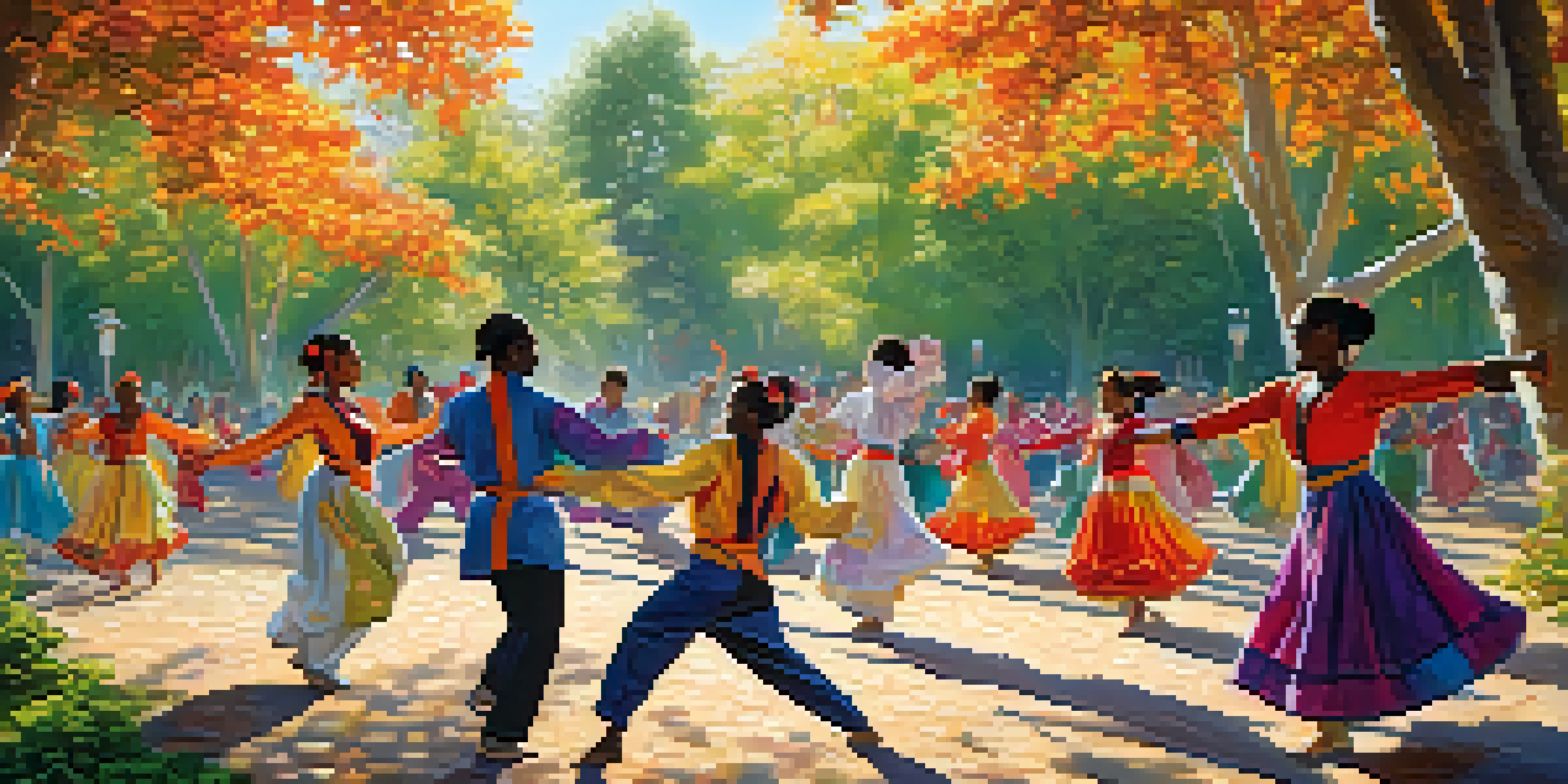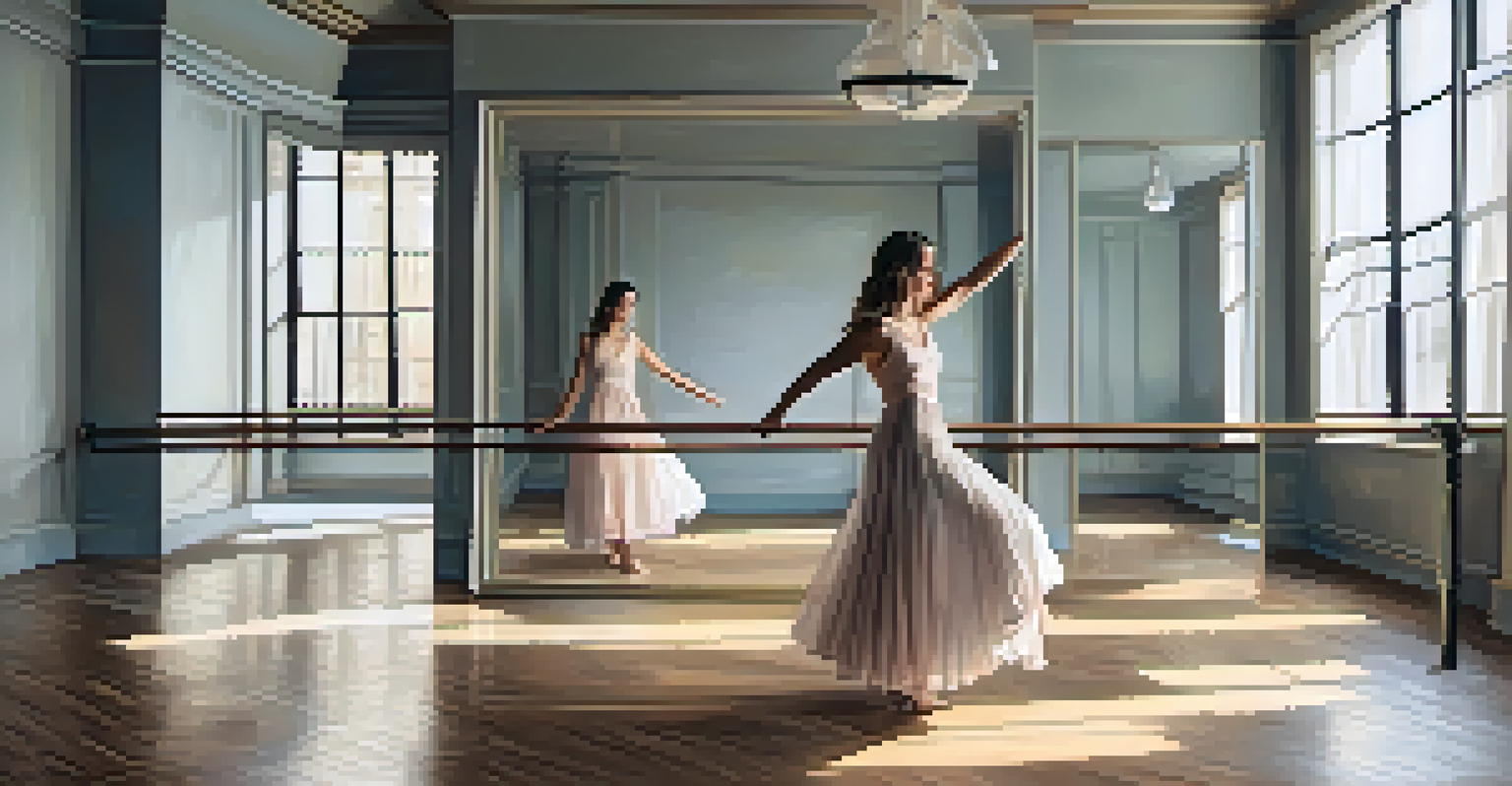How Dance Reflects Social Change in Contemporary Society

The Evolution of Dance as a Reflection of Society
Dance has always been a mirror to the society it inhabits, evolving alongside cultural shifts. Historically, it has adapted to social norms, values, and issues, revealing what is important to different generations. For instance, the emergence of jazz dance in the 1920s symbolized a break from traditional values, as people embraced freedom and self-expression. Today, this evolution continues, showcasing how dance can encapsulate the zeitgeist of each era.
Dance is the hidden language of the soul.
As society progresses, so does the language of dance, often incorporating new styles that reflect current sentiments. The rise of hip-hop in the late 20th century spoke to urban culture, youth rebellion, and social justice issues. Similarly, contemporary dance often addresses themes like mental health, identity, and equality, making it a vital commentary on modern life. Through its dynamic nature, dance remains a potent tool for societal reflection.
Thus, the evolution of dance is not merely about changing steps; it's about capturing the essence of social change. Every movement tells a story, one that resonates with the audience's experiences and emotions. As we witness new dance forms emerging, we can appreciate how they articulate the ongoing narrative of our society.
Dance as a Medium for Social Movements
Throughout history, dance has played a significant role in social movements, serving as a powerful form of expression. From the civil rights movement in the United States to the LGBTQ+ rights movement, dance has often been used to unify and inspire communities. For example, the iconic 'Dancing in the Streets' events brought people together, showcasing solidarity through movement. The very act of dancing became a statement of resistance and hope.

In contemporary society, dance continues to be a rallying cry for various causes. The viral sensation of the 'Dance for Change' challenge on social media highlights how choreography can elevate awareness about pressing issues like climate change and racial injustice. By using dance, activists can reach wider audiences, sparking conversations and encouraging participation in social movements. It transforms the abstract into tangible action, making complex issues more relatable.
Dance Reflects Social Change
Dance evolves alongside cultural shifts, capturing the essence of societal values and issues throughout history.
Moreover, the collaborative nature of dance fosters inclusivity, breaking down barriers that often separate people. When individuals from diverse backgrounds come together to dance, they create shared experiences that promote understanding and empathy. This unity through movement reinforces the idea that dance is not just an art form; it is a vital instrument for change.
Dance and Cultural Identity in a Globalized World
In our increasingly globalized society, dance serves as a powerful means of expressing cultural identity. Traditional dance forms from various cultures are often blended with contemporary styles, creating unique expressions that celebrate heritage while embracing modernity. For instance, the fusion of African rhythms with hip-hop has given rise to a new genre that honors its roots while engaging with current trends. This cross-pollination enriches both the dance community and the cultures represented.
Dancing is creating a sculpture that is visible only for a moment.
However, this blending can also raise questions about cultural appropriation versus appreciation. When dance forms are borrowed without understanding their significance, it can lead to a dilution of cultural identity. Therefore, it is essential to approach dance with respect and awareness, acknowledging the stories and histories behind each movement. In this way, dance becomes a platform for educating others about cultural narratives, fostering respect for diversity.
Ultimately, dance acts as a bridge between cultures, allowing individuals to explore their own identities while connecting with others. It encourages dialogue and understanding, reminding us that while we may come from different backgrounds, our shared love for movement can unite us. Through dance, we can celebrate our differences and find common ground in our humanity.
Technological Advancements and Dance Innovation
The rise of technology has significantly influenced the evolution of dance, reshaping how it is created, performed, and experienced. From social media platforms like TikTok to virtual reality performances, technology has opened up new avenues for dancers and choreographers. For instance, the viral dance challenges on social media not only showcase talent but also create a platform for social commentary, allowing dancers to engage with pressing societal issues in creative ways.
Moreover, technology has enabled artists to experiment with their craft, blending dance with digital art, sound, and even interactive elements. This fusion creates immersive experiences that challenge traditional notions of performance. Dancers can now reach audiences around the globe, transcending geographical boundaries and fostering a sense of community among diverse viewers. Such innovations push the boundaries of what dance can be, allowing for new forms of expression.
Dance as a Tool for Empowerment
Through movement, dance empowers marginalized voices, allowing individuals to reclaim their narratives and express their truths.
As we navigate this digital age, it's crucial to consider how these advancements impact the essence of dance. While technology offers exciting opportunities, it also poses challenges regarding authenticity and connection. Balancing the digital with the physical allows dancers to explore their artistry while staying rooted in the cultural significance of their movements, ultimately enriching the dance landscape.
Dance as a Reflection of Gender Roles and Empowerment
Dance has long been intertwined with societal views on gender roles, often reflecting and challenging these constructs. Traditionally, many dance forms have perpetuated stereotypes, with women often portrayed as delicate and men as strong. However, contemporary dance challenges these norms, showcasing diverse representations of gender and redefining what strength and femininity look like. This shift allows for a richer exploration of identity within the dance world.
Moreover, dance has become a powerful tool for empowerment, particularly for marginalized voices. Through movement, individuals can reclaim their narratives and express their truths. For instance, performances that highlight women's experiences can foster solidarity and inspire change, encouraging audiences to reflect on gender dynamics in their own lives. By amplifying these voices, dance becomes a form of resistance against societal expectations.
As the conversation around gender continues to evolve, so too does the way dance is approached and performed. The rise of gender-neutral dance competitions and the inclusion of non-binary performers showcase a more inclusive landscape. This transformation not only enriches the art form but also reinforces the idea that dance is a universal language that can convey complex emotions and stories, breaking free from traditional constraints.
Dance in Education: A Tool for Social Awareness
Incorporating dance into educational settings can significantly enhance social awareness among students. Dance programs often foster creativity while also encouraging discussions around important topics such as diversity, inclusion, and social justice. Through movement, students can explore these themes in a tangible way, making abstract concepts more relatable and engaging. For example, using dance to interpret literature or historical events allows students to connect with the material on a deeper level.
Furthermore, dance education promotes teamwork and collaboration, essential skills for navigating societal challenges. As students work together to create performances, they learn to appreciate different perspectives and collaborate towards a common goal. This sense of community not only strengthens their interpersonal skills but also cultivates empathy, preparing them to be socially conscious individuals.
Technology Transforms Dance
Advancements in technology reshape how dance is created and experienced, opening new avenues for expression and community engagement.
By integrating dance into the curriculum, educators can create a dynamic learning environment that champions self-expression and social responsibility. Dance serves as a bridge that connects students to the world around them, encouraging them to reflect on their roles within their communities. Ultimately, this holistic approach to education empowers young people to become advocates for change in their own lives.
The Future of Dance in a Changing Society
As we look to the future, the role of dance in society will continue to evolve in response to emerging social issues. The rise of global movements advocating for climate action, racial equality, and mental health awareness highlights the necessity for art forms like dance to address these challenges. Future choreographers and dancers will likely draw inspiration from these movements, creating works that resonate with and reflect the collective consciousness of society.
Moreover, the accessibility of dance will expand, as technology continues to break down barriers to entry. Online classes and virtual performances will allow more people to engage with dance, regardless of their location or physical ability. This democratization of dance not only broadens participation but also enriches the art form by incorporating diverse voices and experiences into the conversation.

Ultimately, the future of dance holds exciting possibilities for social change and expression. As artists continue to push boundaries and explore new themes, dance will remain a vital tool for reflection and activism. By embracing change and innovation, the dance community can inspire generations to come, fostering a deeper understanding of ourselves and the world around us.